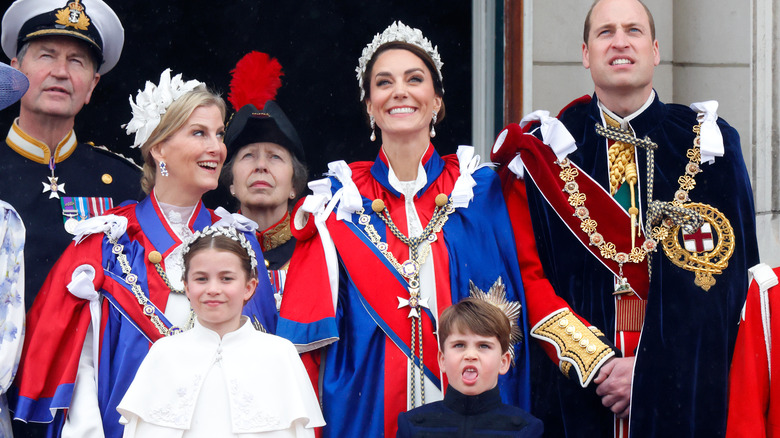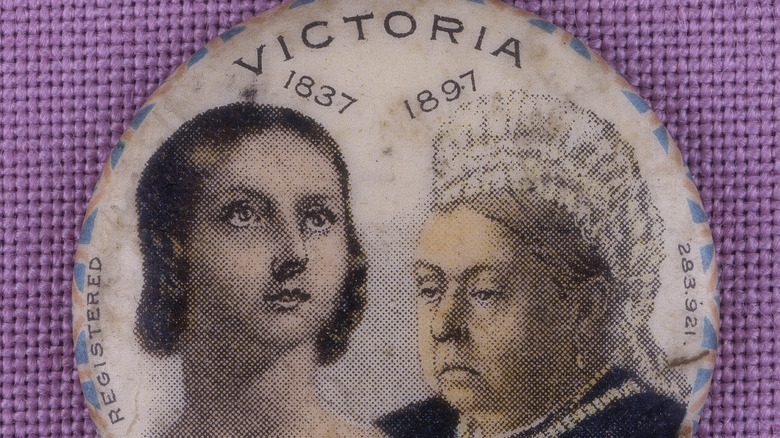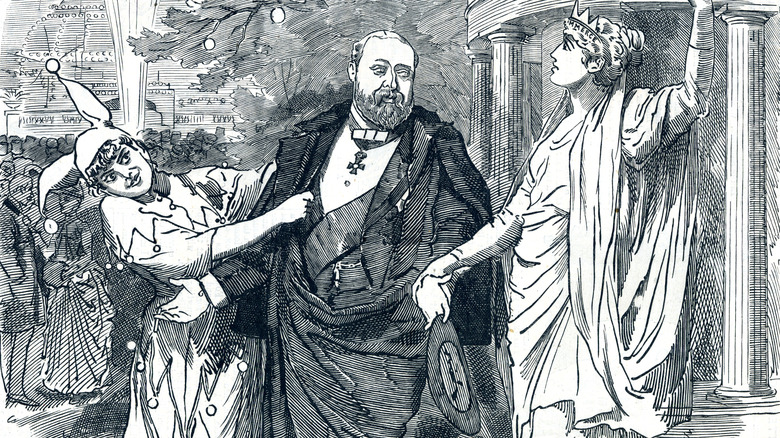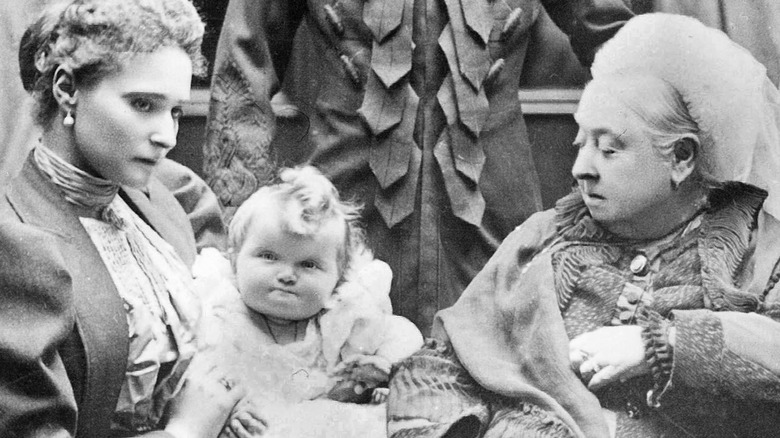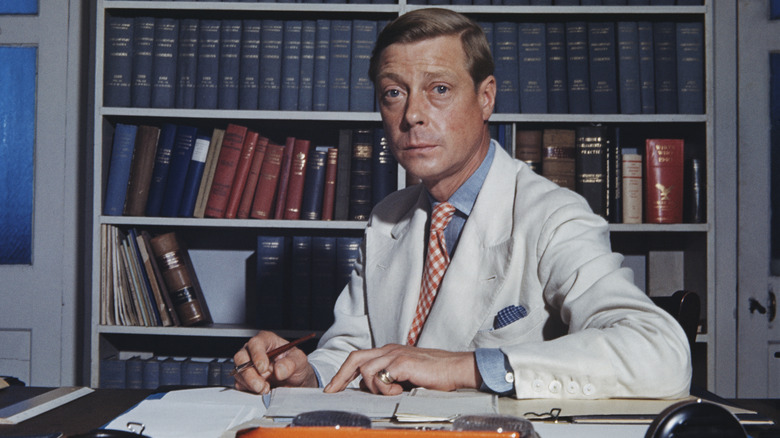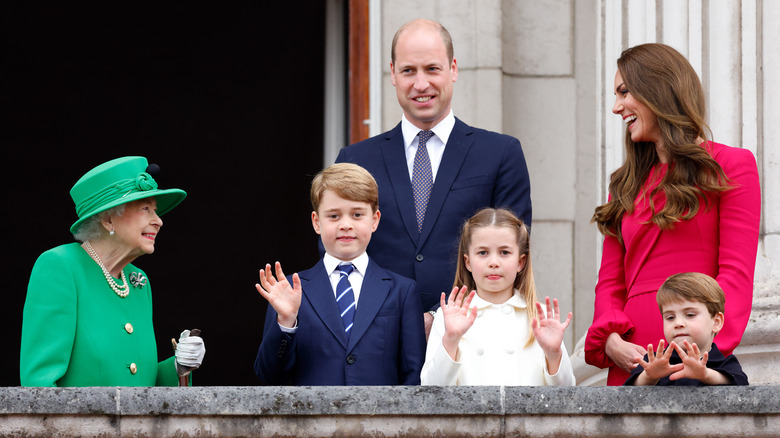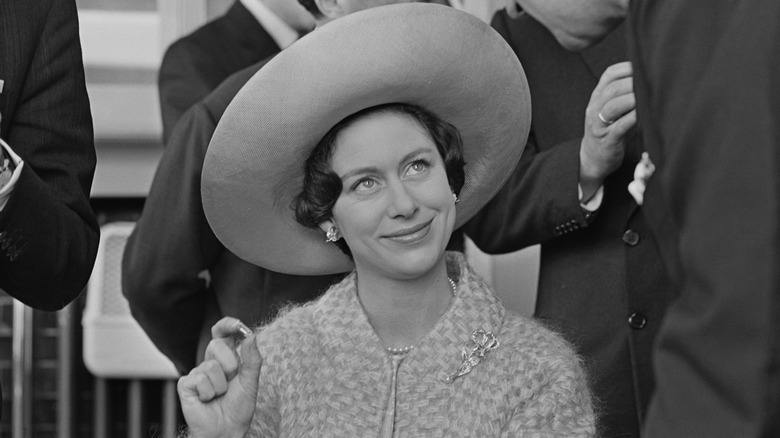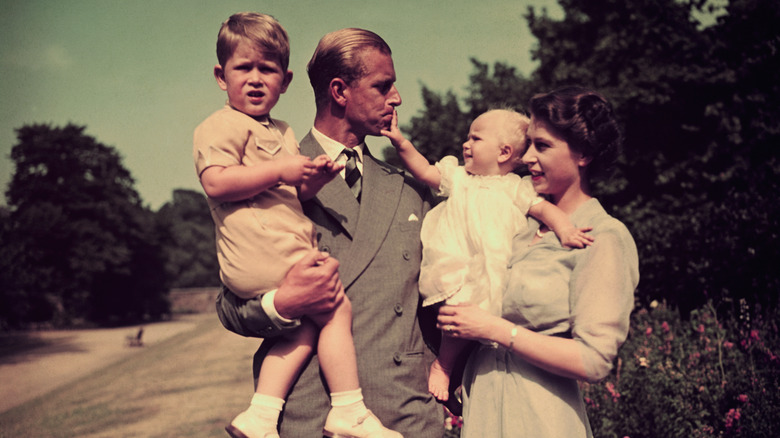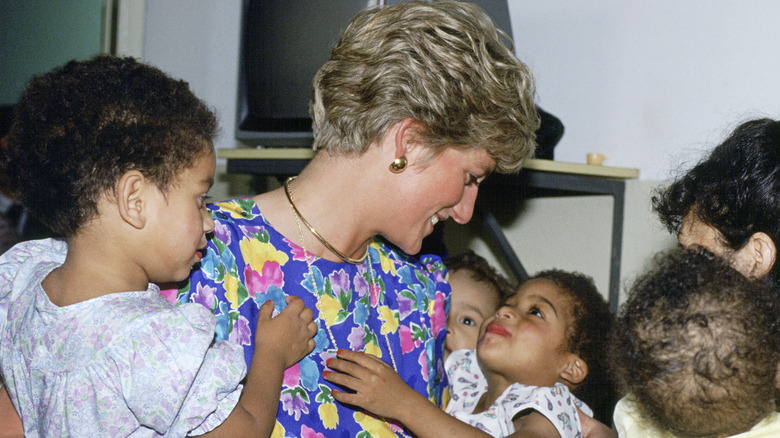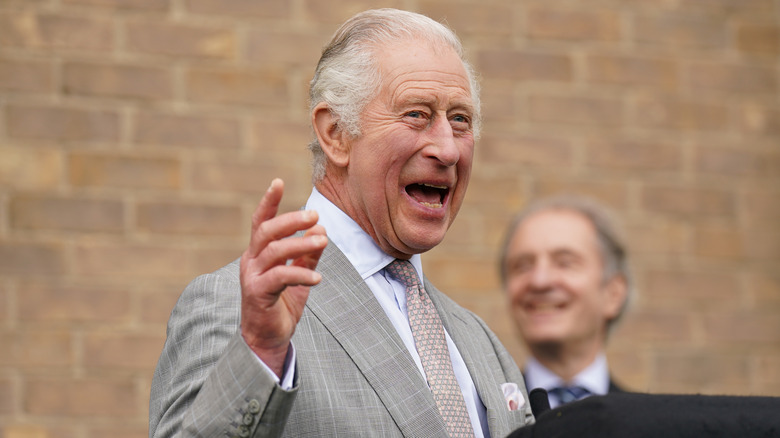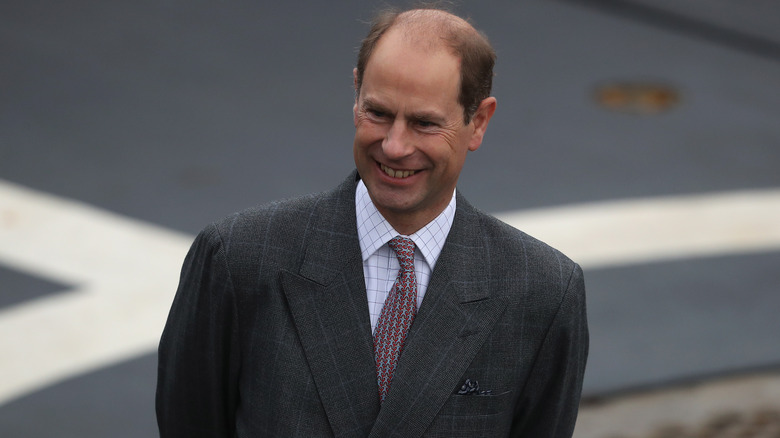Moments Of Royal Rebellion No One Talks About Anymore
When it comes to royal rebellion, no one does it with quite so much charm and aplomb as His Royal Highness, Prince Louis of Wales. Several hours into what was already a long day of religious observance and national celebration on the occasion of his grandfather's coronation on May 6, 2023, the 5-year-old current spare to the throne's cheeky facial expressions from the balcony of Buckingham Palace were every bit as priceless as the looks of bored exasperation famously made by none other than his grandfather – himself age 5, during the 1953 coronation of his mum, the late Queen Elizabeth II.
But mugging for an adoring public is one kind of rebellion — i.e., the kind of which we can't get enough if we're being honest. Quitting the royal family, moving to Southern California, and publishing an eponymous tell-all is quite another. So too is cavorting with the sort of characters of whom the royal family would never approve, dating a convicted murderer, or getting inked. Of course, these are all still fairly in our faces, so what is there to say that hasn't already been said?
But what about the royal acts of rebellion no one talks about anymore? You know, the ones long forgotten or swept under the rug. Or those that with the passage of time just don't seem all that eyebrow-raising nowadays. Let's take a look at some of those more rebellious royal moments that no one seems to talk about much anymore.
Queen Victoria's protracted mourning was against protocol
Remember how when Prince Philip died in 2021, Queen Elizabeth II — his widow after 73 years of marriage, mourned for a respectful eight days before getting back to carrying out the usual tasks attendant to being the British Sovereign? Sure, the royal family's actual period of mourning continued beyond that, but within two weeks after the Duke of Edinburgh's death, it was business as usual for the entire family. Likewise, when the queen died in 2022, the royal family observed a seven-day period of mourning following the funeral. And not a moment too soon, according to Time, which points out that even a period of mourning as brief as that which was observed for the queen dealt something of a blow to Britain's economy.
But that's not how things went down when Prince Consort Albert died in 1861 at age 42. The death of her beloved husband sent Queen Victoria into a protracted period of mourning that ceased only upon her own death in 1901. In the meantime, the queen's refusal to buck up and get on with her life — including eschewing public appearances — led some to call for her abdication. Even when she did eventually begin to make public appearances again, she was always dressed in black mourning attire. Is it any wonder that under the queen's influence, Victorians became infatuated with death?
King Edward VII's shameless cavorting
Queen Victoria's bereavement over the death of Prince Albert may have been complicated by ambivalent feelings she had toward her son and heir to the throne, Prince Bertie, who became King Edward VII in 1901. Even before the premature death of her husband, Victoria's relationship with Bertie was problematic, per Town & Country, and not just because the future king didn't take his studies seriously. Indeed, there was a lot Bertie didn't take seriously in his youth, or throughout his life, for that matter, including and with a particular emphasis on his relationships with women.
Long before Prince Andrew acquired the nickname, Randy Andy, there was Edward the Caresser, Prince of Wales. Bertie's antics with women, including Alice Keppel, the great-great-grandmother of Queen Camilla, with whom Bertie took up at the turn of the 20th century while married to Queen Alexandra, famously vexed Victoria. She even blamed the death of Prince Albert on Bertie's womanizing. "I never can or shall look at him without a shudder," she wrote of her eldest son in her journal, according to the BBC.
And it's easy to see why she might have felt this way, given that Albert's health began to deteriorate as a final matter immediately after a fraught meeting with Bertie on a cold November day, during which he urged Bertie to please stop cavorting with sex workers. Bertie did not quit his cavorting then, or likely ever. And Victoria never fully forgave him.
This British princess refused to marry the heir to the throne
Since the British monarchy is a blood dynasty, whom their senior members marry is a matter of great importance not only to the royal family but also to many who dwell in the U.K. That's why parliament passed the Royal Marriages Act of 1772 so that those in line to the throne would only be able to marry someone deemed worthy of the role. Still, long before Prince Harry had to ask the queen for permission to marry the American actress and divorcee, Meghan Markle, matchmaking tended to dictate who married whom. Or that's how it was supposed to work when, for example, Queen Elizabeth fell in love, while still the young teenage Princess of York, with a member of the deposed royal family of Greece — her future husband, Prince Philip.
But as far as rebelling against the family's matchmaking plans go, no one can hold a candle to Princess Alix of Hesse and by Rhine, a granddaughter of Queen Victoria. First, she refused to marry her cousin, Eddy, the eldest son of Prince Bertie of Wales and therefore a shoo-in to be king one day had he not ultimately died of influenza during Queen Victoria's lifetime. Then she up and married the heir to the Russian empire, Tsesaravich Nicholas.
When the Romanov family was famously gunned down in 1918 by Bolshevik revolutionaries, Tsarina Alexandra was among the dead, as were her husband and five children, including the young princess immortalized in "Anastasia."
King Edward VIII rebelled by quitting the throne
In 1970 King Charles, then the Prince of Wales, met Camilla Shand, and the two hit it off. Though the pair were reportedly smitten with each other, Charles went on a months-long military deployment, and by the time he came back, Camilla had married someone else. According to Town & Country, she would not have been an acceptable choice to marry the future king of England, regardless, and the royal family introduced a younger, fresher Lady Diana Spencer. Still, Charles eventually rebelled by picking back up with Camilla after he and Diana married.
Even if Camilla would have been available, it's hard to imagine Charles not doing his duty and marrying the woman chosen for him, but not all royal family members have been so willing to allow their royal obligations to dictate their choice of partner. Indeed, when the British government failed to support King Edward VIII's decision to marry Wallis Simpson, an American divorcee with whom he had been romantically involved for at least two years prior, he responded by abdicating the throne on December 11, 1936 — not even one year into his reign, before he'd even had his coronation.
As he put it, "I have found it impossible to carry on the heavy burden of responsibility and to discharge the duties of king, as I would wish to do, without the help and support of the woman I love" (via History). But some suspect that Edward VIII had not been adequately prepared for the throne by his father, George V, and, therefore, some form of rebellion on the part of the rookie king had been preordained.
Queen Elizabeth II eliminated a millennium of male primogeniture
When Princess Anne was born in 1950 to Queen Elizabeth II and Prince Philip, she stood second in line to the throne after her older brother, then Prince Charles of Wales. But her status as such was, by definition, precarious — as a result of male primogeniture. The then-prevailing order-of-succession rubric, it dictated that the birth of a newborn male sibling would usurp an older female royal family member's place.
And so, the birth of her two younger brothers set Anne back in the order, and so would the birth of every male heir born to any of her brothers. Hence, Anne is now one of the most prominent senior members of the royal family; yet she stands only 16th in line to the throne because her place has been bumped so many times.
Thanks to an act of rebellion by Queen Elizabeth II, however, that's something that will never happen to Princess Charlotte, the second child of the Prince and Princess of Wales — aka, Prince William and Kate Middleton. The reason is that in 2013, Queen Elizabeth II did something completely radical and previously unheard of since the inception of the British monarchy in 1066. She abolished male primogeniture in the royal order of succession. As a result, when Princess Charlotte was born, her place as number three in the line of succession was preserved regardless of whomever might be born in the future, including, as it turned out, her baby brother Prince Louis.
Princess Margaret turned her status as spare into a rebellious art form
When King Edward VIII abdicated in 1936, he permanently rerouted the royal line of succession. With the Duke of York having acceded to the throne, the new king's eldest child, Elizabeth had, in an instant, gone from "heir of the spare" to heir presumptive. It took some getting used to by the then-Princess Elizabeth, who would one day become queen. But some maintain it took even more getting used to on the part of Elizabeth's younger sister, Margaret.
Previously, Princess Margaret had been just like any minor royal family member, living in relative obscurity except during major royal events like the Trooping of the Colour. Now, her life was to be lived under the microscope of the public eye, but with no promise of becoming queen. "Now that Papa is king," Margaret is said by Biography to have remarked in childhood, "I am nothing."
But rather than view "nothing" as a curse, Margaret took the opportunity to live as she pleased in full view of the public gaze, but without fear of how this or that would behavior would look in a future queen. She smoked in public — something a future queen could not then do. According to Biography, she fell in love with a divorcee (scandalous at the time), later married a photographer, then took up a relationship with a younger man before becoming the first royal to divorce in 400 years, and lived as an impeccably attired bon vivant for the rest of her life.
Prince Philip said whatever was on his mind
Princess Margaret took the view that if she wasn't going to be queen, then she wouldn't have to comport herself like one. Her rebellion took the form of inappropriate lovers and partying until dawn with the mid-20th century equivalents of reality TV stars. Conversely, Prince Philip, who also apparently took the view that if wasn't going to reign, then why not enjoy a bit of freedom, rebelled by not having to keep calm and carry on in the style of his wife, the always composed and never rattled Queen Elizabeth II.
Prince Philip, in addition to being Queen Elizabeth's strength and stay, was the royal family's equivalent of Archie Bunker, calling things as he saw them and not caring how it sounded. To paraphrase CNN, when Philip died, he left behind a metaphorical slam book of outrageous one-liners that made a hilarious, albeit sometimes deeply offensive argument that it's good to be the queen, but it's a heck of a lot more fun to walk several paces behind and speak without a filter.
Among his tamer bon mots, Philip declared Beijing "ghastly" while on a royal engagement in China. He also joked to a group of hearing-impaired students standing near a Caribbean steel drum band that "no wonder" they're "deaf," per The Guardian. More classic Philip-isms can be found here.
Princess Diana's failure to obey was pre-ordained
"In a break with royal precedent, Lady Diana Spencer has decided that she will not promise, at her wedding four weeks from today, to obey Prince Charles," The New York Times reported on July 2, 1981. And it was true. In her vows on July 29, Diana became the first royal ever to promise to love, comfort, honor, and keep their spouse in sickness and in health, but not necessarily to obey, as one did. Well, she didn't actually put it that way so much as skip over the word "obey."
For better or for worse, however, Diana's small but significant act of rebellion was undercut somewhat by the Church of England's validating the young woman's decision as delightful and "more Christian" than the alternative. And so it would be in other ways too that she would also famously rebel, including by engaging in various indiscretions with men who apparently treated her with more affection than her husband, wearing a short black cocktail dress (the "revenge dress") to a nighttime public engagement (the same day as Charles publicly admitted to some of his own indiscretions), cutting some rug with John Travolta, and, much more significantly, offering warmth and compassion to those suffering from disease and impoverishment. And let's not forget the time she presented Prince William, age 13, with an erotic cake shaped like female breasts.
Prince Charles confesses publicly to cheating on Diana
One of the many unwritten rules by which the royal family must abide is that when it comes to infidelity, there is no choice but to keep calm and carry on. Or, to put it another way, stuff happens, but no one has to know, and no one should ever talk about it — not even to deny it. Or at least that's the rule by which members of the royal family, have always been expected to conduct themselves, at least prior to June 30, 1994, when Charles told the world that yes, he did engage in an extramarital affair with Camilla Parker-Bowles. But only after his marriage had deteriorated irretrievably, he added.
It's not like the cat wasn't already out of the bag, of course. Tampongate, the 1989 scandal in which excerpts from audio tapes of lascivious chatter between Charles and Camilla were released to the public was already five years in the rearview by then. But it was definitely a case of Charles marching to his own drum when he both addressed and confessed his extramarital infidelity during a televised broadcast. Indeed, when Charles did so, he realized he was "living dangerously," as he wrote in a letter to a friend, per Yahoo News.
That time when Prince Edward quit the Marines
It's not a rule, per se, but there's a longstanding tradition that senior members of the royal family should serve for some period of time in the military. "Originally, it was seen as a means of instilling discipline and countering any image of idleness," the Los Angeles Times wrote in January 1987 — in conjunction with its report that Prince Edward, Elizabeth's youngest child, had quit the military after a sharply truncated stint.
Prince Edward joined the Royal Marines in 1986, soon after he graduated with an undergraduate degree from Cambridge. He committed to a 12-month officer training program. Four months in, he resigned – much to the distress of the queen and, apparently, the irritation of some of his countrymen. Nor did it go over well with his father. Prince Philip achieved high ranks in both the Royal Navy and the Royal Air Force. The LA Times noted that Philip made a valiant attempt to get Edward to change his mind.
When the public questioned whether Edward quit because he couldn't hack it from a physical fitness standpoint, Edward's friends countered that he was cut out for something that was more intellectually challenging.
Prince Harry wore a Nazi costume for Halloween, later blamed it on William
Unlike his Uncle Edward, Prince Harry had a long and distinguished military career. It began in 2005. Unfortunately, that year is also the one during which Harry rebelled against the constraints placed upon him as the spare to the heir by dressing as a Nazi for a costume party.
Harry did end up apologizing amid criticism by The Simon Wiesenthal Center in Los Angeles and various other Jewish groups as well as Jewish lawmakers. But if anyone happens to be keeping track of the various times that Harry disappointed his grandmother over the years, we certainly hope you'll have this incident on the list. Apparently, it happened amid preparations for the queen to commemorate the Holocaust as well as the 60th anniversary of the liberation of Auschwitz, with a reception at St. James Palace, to which Nazi death camp survivors were invited, along with members of the British military who were involved in liberating them.
Moreover, Harry also went on to throw his brother and sister-in-law under the bus by claiming it was William and Kate who convinced him to dress as a Nazi. But that wasn't until much later as it didn't emerge until word began to spread that the anecdote would appear in Harry's memoir, "Spare," per Page Six.
Prince William's decision to attend St. Andrews over Oxford was just the beginning
If Prince William has, indeed, engaged in extramarital relations with Rose Hanbury, that probably wouldn't count as a royal rebellion, given the apparent normalization of such incidents. But that doesn't mean William has never engaged in his share of royal rebellion. For one thing, he blatantly broke with royal tradition the moment he enrolled in St. Andrews University in Scotland, rather than Oxford or Cambridge like the rest of his family has been doing for the last 150 years, according to Express UK. On the other hand, however, it turns out he made the queen proud because he was following in the 16th-century footsteps of the Scottish King James V of Scotland.
And while the royal family apparently couldn't be any happier with how things have turned out with William and the former Kate Middleton, the fact remains that when he met her, she was a college co-ed commoner. And a fun one at that, at least to the extent she was willing to strut a charity fashion show catwalk in a $40 see-through dress. Of course, she wasn't yet a royal back then. In fact, she and William were not even dating, although things changed rapidly after that evening. As the royal family continues to forge ahead into modern times, only time will tell how the centuries-old protocols will hold up among the younger generations.
